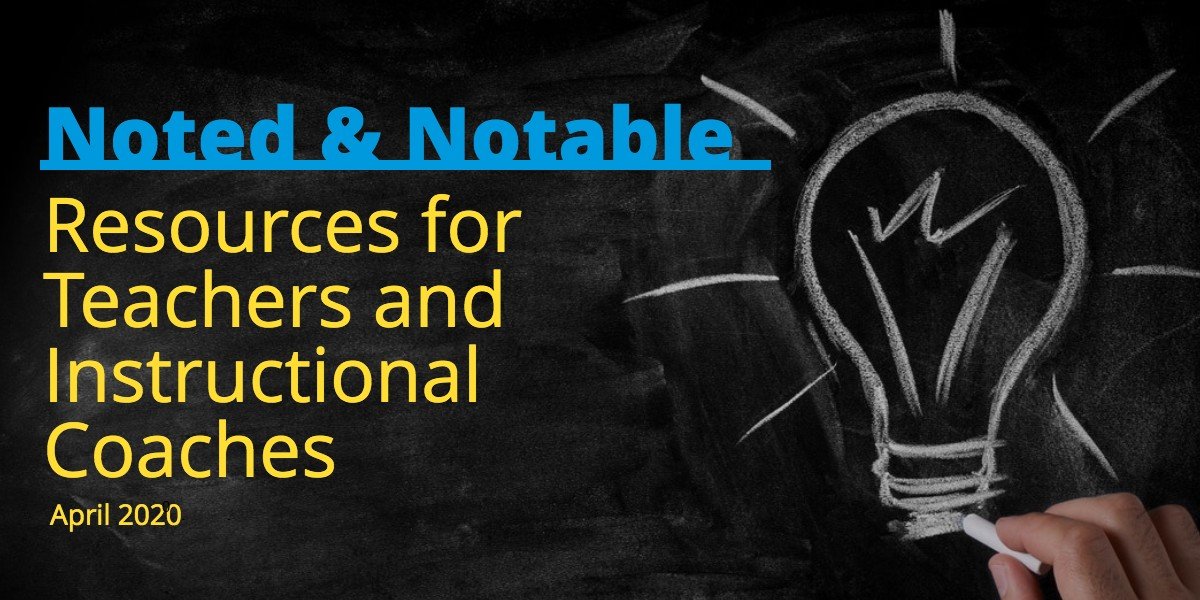Resources for Teachers & Instructional Coaches – April 2020

We are now rolling into our second month in which learning-from-home has become the new normal. Some states have already canceled in-person classes through the end of the academic year due to COVID-19.
It’s tempting to focus all our attention on the technical “how-to” for online and distanced teaching. But now, more than ever, educators need professional development about how to keep student engagement high in these new learning contexts. Here are some resources and articles for educators on this topic.
Supporting educators teaching from home
Teacher readiness is vital as classes have moved online. It is difficult to train educators to use the many digital tools that are now needed. However, school leaders must remember that professional development can still happen during this time.
In a remote learning guide published last March, leaders from the Consortium for School Networking (CoSN) noted that teacher readiness and preparation is a key consideration for districts that are contemplating moving classrooms online.
“Teaching online requires specialized skill sets including an understanding of how to conduct classes in a virtual environment, knowing when and how to use videoconferencing, share content, respond to students’ submissions and more,” according to the guide.
CoSN also listed out other questions districts must answer as they prep teachers for remote learning, such as how and when they should deliver classroom content and how to best prepare teachers who have never taught in an online environment before.
Read more on EdTech Magazine: How to Prepare and Support Educators Teaching from Home
Educators should tailor remote classes to fit students’ needs
Even during an in-person lesson, teachers must differentiate their instruction based on the variety of student cognitive level. This same practice must be done for remote teaching environments. Educators must balance the different learning perspectives as students continue to adjust to distance learning.
Educators must balance the needs of those who enjoy the solitude of remote learning with the needs of those who miss the buzz of the classroom. This will involve accounting for different ways students experience change and helping some cope with isolation.
In tailoring their approach for students’ learning styles, educators should keep in mind differences in the four areas of personality based on the Myers-Briggs® framework. While most teachers won’t have the luxury of giving each student a personality assessment, they likely have an understanding of their students’ preferences.
Read more on District Administration: Online learning: Balancing students’ diverse communication, learning styles
Synchronous or asynchronous: when should your classroom be live?
Education experts offer advice on the things to consider when deciding when your teaching should be done through a live video or when it would work better through a self-paced mode.
As professors and K-12 teachers adjust to the sudden move to online teaching, one question keeps coming up: How much of class time should be done live—known in education parlance as “synchronous” teaching—and how much should be done so that students can do the work at their convenience—or “asynchronous” teaching.
Experts in online teaching have been debating and researching the question of synchronous versus asynchronous for decades.
The overall advice from experts is to mix both formats in any given class. “The challenge I see in this debate is the dichotomous thinking,” says Bonni Stachowiak, dean of teaching and learning at Vanguard University of Southern California and the host of the Teaching in Higher Ed podcast. “If we stick to one or the other (synchronous versus asynchronous), we are going to be leaving someone out.”
Read more on EdSurge: When to Teach Online Classes Live and When to Let Students Learn on Demand

